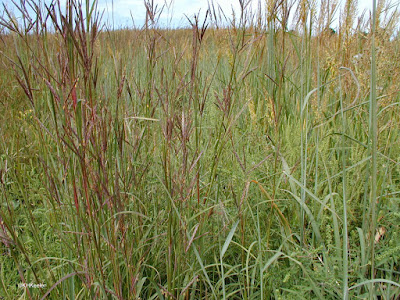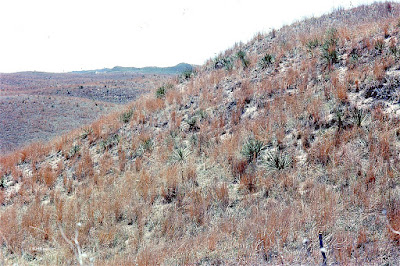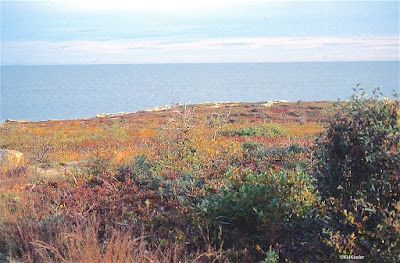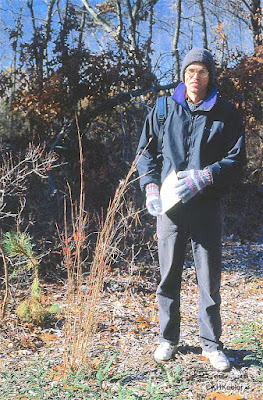 |
| little bluestem in the prairie |
Little bluestem grows to be about 3 feet high, making it a midgrass in grassland terminology. It is a bunch grass, meaning it forms clumps which only slowly get larger.
 |
| little bluestem fall colors |
Historically, little bluestem was one of the five major grasses of the tallgrass prairie, an ecosystem which stretched from Tennessee to Kansas across the central U.S. (see map on Wikipedia link). Tallgrass prairies were dominated by tall grasses, grasses that grew to more than 6' tall. In that environment, little bluestem is inconspicuous, but the more you look for it, the more you find. When ecologists counted and measured grass abundance, it was regularly one of the top five grasses (in an ecosystem that was 90% grass), a major part of the community.
 |
| tallgrass prairie. Little bluestem is in there but topped by the tallgrassses |
 |
| Dry hillside of little bluestem in western Nebraska |
Farther west on the plains, there isn't a enough rain for little bluestem to dominate, but it is easy to find in moister spots. It is very drought-tolerant with roots that go down more than four feet for water, but it is not a desert grass.
Turning east, in the forests of eastern North America, it can be found on drier sites such as rock outcrops, taking it all the way to the Atlantic coast.
 |
| Little bluestem at the bottom of the photo to the left, Atlantic Ocean on the horizon in Massachusetts |
The seeds are pretty, covered with fluffy-looking white hairs. The seeds are important food for birds, in both fall and winter, and feed small mammals as well.
 |
| seeds on little bluestem |
 |
| American bison. This one is shedding. Most little bluestem seeds were found in shed hair. |
 |
| My 6'3" husband gamely demonstrates how tall little bluestem can get. November, Long Island, New York |
Important in native grasslands and now making itself a place in horticulture, little bluestem is a very adaptable grass.
Comments and corrections welcome.
Sources included not referred to above
Eyheralde, P. G. 2015. Bison-mediated seed dispersal in a tall grass prairie reconstruction. Iowa State University Ph.D. online at link
Little bluestem Missouri Plant Finder link
Rosas, C. A., D. M. Engle, J.H. Shaw, and M. W. Palmer. Seed dispersal by Bison bison in a tallgrass prairie. Journal of Vegetation Science. 19: 769-778.
USDA Natural Resources Conservation Service Plant guide. Little Bluestem. link
USDA Plants data base
Kathy Keeler, A Wandering Botanist
More at awanderingbotanist.com

I love this species and have seen it in so many different places. It's native where I'm at, but the most impressive stands of S. scoparium that I've seen were in New Hampshire, though I've also encountered it in New Mexico and New York.
ReplyDeletehttps://poasession.blogspot.com/2019/09/little-bluestem-schizachyrium-scoparium.html